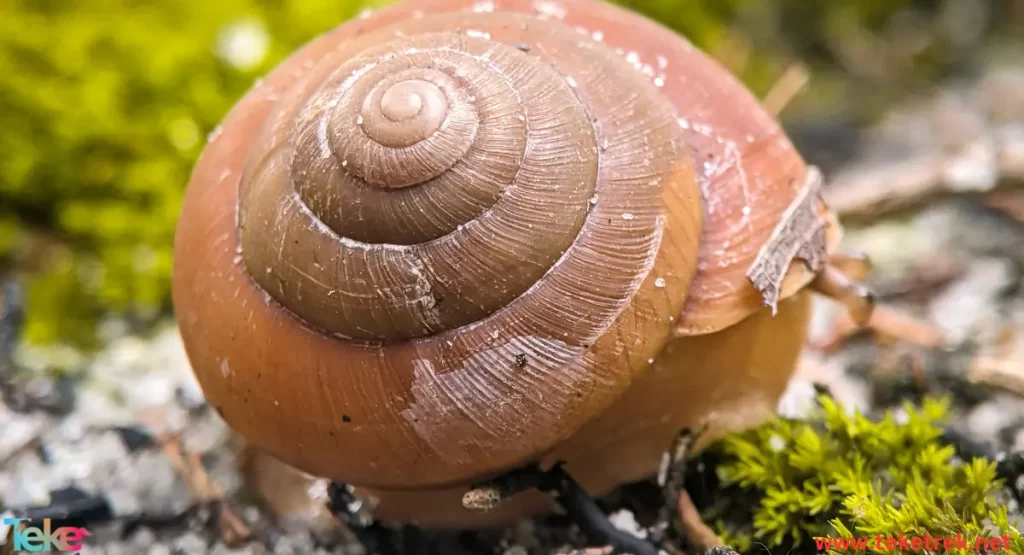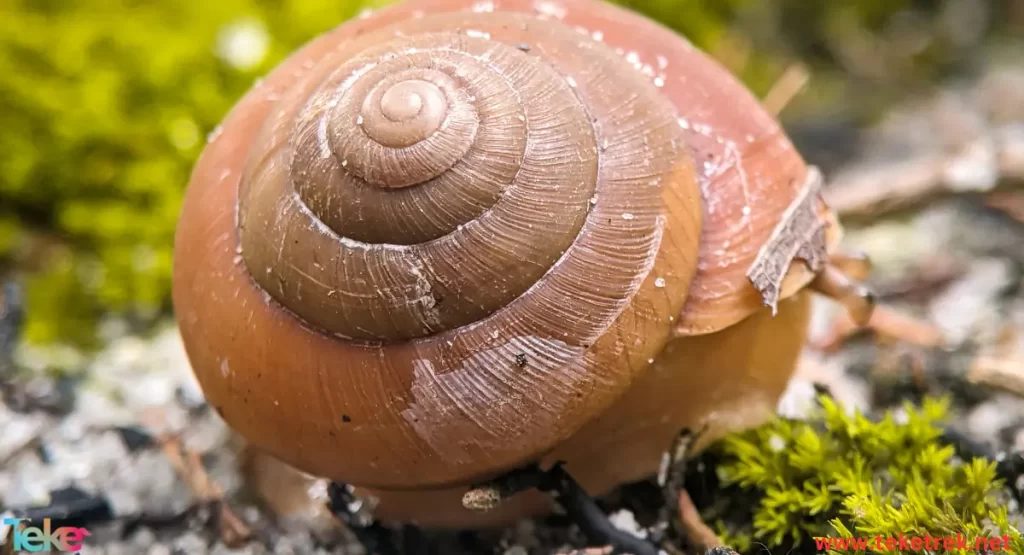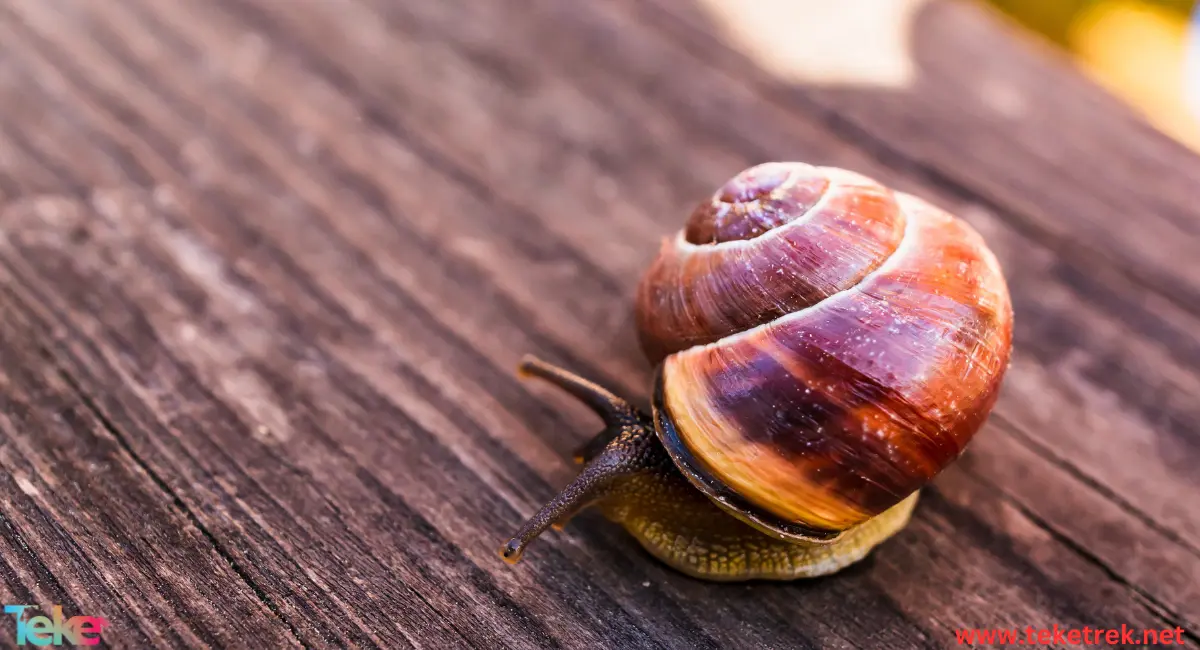The snail is the largest subcategory of gastropods, encompassing thousands of species, found all over the world, both underwater and on land. Also snail meat is considered a high-quality food rich in protein and is also a major source of iron. It contains 15% protein, 80% water, and 2.4% fat, making it a substitute food for people in need of a high-protein, low-fat diet. Additionally, snails are rich in essential fatty acids such as linoleic acid and linolenic acid. If you’re interested in learning about snails and their lifestyle, continue reading this article from Teketrek.

An introductory paragraph about Snail shape
- Snails typically have a single shell coiled spirally, although the shell may be absent in some groups.
- Most snails have an operculum, which is a plate that closes the opening of the foot’s visceral cavity.
- Snails have a true body, divided into three parts: the head, the muscular foot, and the visceral mass, along with organs for respiration, circulation, excretion, digestion, reproduction, and nervous transmission. Their body plan twists during larval growth due to the visceral mass twisting 180 degrees relative to the head. The mantle cavity brings water to the animal’s anterior portion.
- The nephridial, anal, and genital apertures are located near the front of the animal.
- Most snails are herbivorous by nature, but many marine species and a few terrestrial ones can be carnivorous.
- Snails have 1-2 pairs of tentacles on their heads. In terrestrial snails, the eyes are carried on the tips of the first pair of tentacles and are about 75% of the eye’s width. The second pair of tentacles functions as olfactory organs.
- Snails possess a ganglionated nervous system, representing a primitive type of brain divided into four sections. This structure is simple compared to the brains of mammals, birds, and reptiles.
- Snails move by rhythmic body contractions through extension at a slow speed of 1 mm per second.
The Function of Mucus in Snails
The mucus secreted by snails acts as a protective layer that maintains the moisture of their skin, providing protection against dehydration and injuries.
The mucus reduces friction between the snail’s body and the surface it moves on, making movement easier for it.
The mucus contains important nutrients that snails can use as an energy source or for tissue building. It contains antibacterial and antifungal substances that prevent their proliferation on the snail’s skin, protecting it from infection.
Habitats of Snails
Most terrestrial snails inhabit a wide range of places: wetlands, forests, meadows, and even deserts.
Soil composed of limestone and other limestone rocks is more suitable for land snails because it provides the calcium they need to form their shells.
If you’re looking for wild snails, turn over rocks, tree trunks, fallen bark, and examine cracks in the base of large trees, especially walnut, oak, hawthorn, and sugar maple. You can also find wild snails in urban areas.
In general, wild snails are sensitive to dry conditions, so they are usually found in moist, shaded, and cool places that provide the organic matter they eat.
They are usually found among leaf litter in forests, near the ground in wet fields, and in wetlands. And snails lives between vegetables and ornamental flowers.
Dietary Habits of Snails
In the wild, snails consume various foods such as fruits, leafy plants, algae, and organic matter. They cause damage to agricultural crops as well as garden plants. Nevertheless, they are considered pets.
Most terrestrial snails eat dead and decomposing plant material, as well as fungi and associated bacteria. Some are herbivores, feeding on grasses, leaves, soft stems, fruits, vegetables, and flowers.
They may also consume animal feces, tree sap, and dead animals. They may also obtain the necessary minerals to build their shells by scraping limestone rocks or dead snails.
Some species are carnivorous, feeding on earthworms, roundworms, or even other snails and their eggs.
Fascinating and Amazing Facts about Snails
There are over 65,000 known species of snails around the world, varying in shapes, sizes, colors, and behaviors.
Snails are considered slow animals, capable of crawling at speeds ranging from 0.013 to 0.002 meters per second only.
Despite their slow movement, snails can climb on vertical surfaces and even safely descend from long distances thanks to their mucus secretion.
No two snails have the same fingerprint; each snail has a unique fingerprint used for identification.
Snails have a sophisticated sense of touch that enables them to recognize food, surfaces, and potential mates through tactile sensations using their moist bodies.
The colors of snails can vary greatly and include white, black, yellow, blue, pink, red, brown, green, and purple.
Snail life cycle
Most often, the snail is hermaphrodite, with male and female reproductive organs, which makes reproduction easy. Its life cycle passes through the following stages:
Lay eggs
When a snail fertilizes the eggs of another snail that lays eggs by digging holes in the soil, it occurs from late fall to early spring.
Hatching
Two weeks after laying the eggs, the chicks emerge and then eat their own eggshells, and sometimes the eggs of other snails. The young snails continue to feed and grow throughout the winter and spring.
Juvenile snail
In the summer, snails go through a dormant period where they rest on the soil surface and climb walls, roads and plants in order to reduce water loss. This process continues until it reaches maturity. Snails may be active if it rains in the summer, but they do not mate or reproduce.
Adult snails
Snails become sexually mature in early fall, when cold and wet conditions stimulate their activity. Then, two to three weeks after rainfall, the snails’ mating season begins.
Egg laying begins shortly after mating, and the life cycle repeats.


Snail types
Some Interesting and Remarkable Species of Snails:
Candy Cane Snail
This snail is characterized by its conical white shell adorned with distinctive rainbow-colored stripes. It can be found in the Caribbean region, especially on the island of Hispaniola. The Candy Cane Snail is arboreal (tree-dwelling) but lays its eggs in the sand.
Sea Butterfly Snail
Instead of crawling along the forest floor, this species evolved feet into wing-like flaps, allowing them to swim in the upper part of the water column up to 80 feet from the North Pole to the southern oceans. They are one of the most abundant species globally but are threatened by ocean acidification.
African Giant Land Snails
These are the largest known species of terrestrial snails. They typically reach a length of about seven inches from nose to tail and have a diameter of about 3.5 inches. African Giant Snails are voracious eaters, feeding on about 500 species of plants. If fruits or vegetables are not available, they will consume whatever is available, including paint and plaster on houses.
Golden Elephant Snail
The Golden Elephant Snail is characterized by its mango-colored hue and ears resembling those of a rabbit. Most of them are restricted to the Bosu and Malili Lake systems in Indonesia. It already uses its trunk to search for food in the sand, but the “ears” are sensing horns.
Golden Apple Snail
It is considered agriculturally and economically significant as a food source in some regions. It is characterized by its spherical shell and varied colors, which may include golden hues.
Purple Sea Snail
Characterized by its beautiful purple shell, it has the ability to travel long distances in the oceans. This species can be found in tropical and warm temperate waters worldwide, with some found in semi-tropical oceans of the Atlantic, Indian, and Pacific Oceans.
FAQ
- Are snails good for your garden?
Snails can have mixed effects on your garden. They contribute to soil health through decomposition and aeration, but they can also damage plants and become pests if their population is not managed.
- What is the lifespan of a snail?
Snails can live anywhere from one to several years, with some species living up to 10-15 years in optimal conditions.
- What does snail eat?
Snails are herbivores and typically feed on a variety of plant matter such as leaves, fruits, vegetables, and algae. They may also consume decaying organic matter and occasionally fungi or small insects.
- Are slugs and snails the same?
Slugs and snails are similar in many ways, but they are not the same. Both belong to the class Gastropoda, but snails have a shell while slugs do not. Additionally, snails move with the aid of their shells, while slugs move by secreting mucus and gliding along surfaces.
- Is it safe to touch snails?
Yes, it is generally safe to touch snails, but it’s important to wash your hands afterward as they may carry bacteria or parasites that could potentially cause illness if ingested. Some people may also be allergic to snail mucus, so it’s best to avoid contact if you have sensitive skin or known allergies.
In conclusion, it is known that snails are one of the oldest living animals on this planet. Fossil records discovered confirm that these creatures have been alive for 500 million years. There are several species of snails, but they are mostly classified based on their habitat – terrestrial and aquatic snails.






